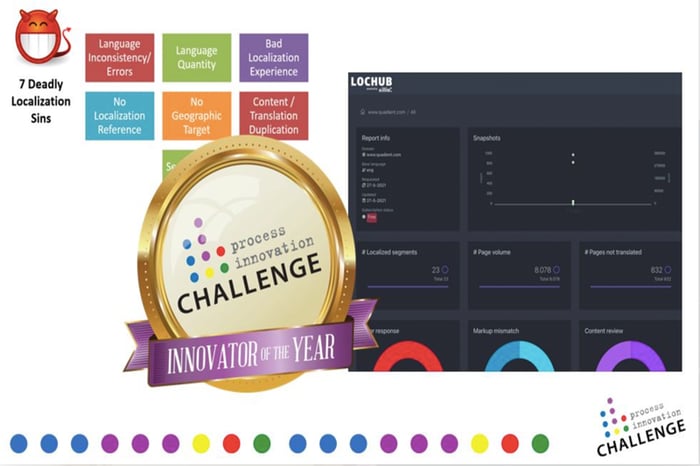Localization is a business enabler, not a “nice to have”
by Yuka Nakasone, on Sep 27, 2021 9:57:43 AM
This blog is part of a series of three articles written by Yuka Nakasone, an international growth strategist, and localization industry expert. A few weeks ago, Yuka caught up with Rikkert Engels, CEO, and founder of LocHub, to discuss globalization trends, issues facing localization professionals, and industry innovation. The second article explores the value of localization to business stakeholders, explains how localization managers can boost the visibility of their projects and shows how effective localization directly contributes to corporate revenue growth.
Did you know that the total number of Mandarin Chinese speakers is almost the same as the total number of English speakers? The number is well over 1 billion, which means two things. Firstly, we’re talking about a huge business opportunity for companies with international expansion on their roadmap. However, it also means that entering a new market in these languages implies many localization challenges to tackle. The Asian market is just one example.
Many companies underestimate the value of localization in the first place. Led by the belief that English is the common tongue of people around the world, they miss out on a valuable chance to increase their market share and connect with new audiences across borders.
So, why is that? How come so many companies treat localization as an afterthought? Moreover, why do some localize their websites, but do it so poorly? Valuable answers come from Rikkert Engels, CEO, and Founder at Xillio and LocHub.
Localization should be an integral part of your expansion strategy
Engels won this year’s LocWorld PIC with LocHub, and the solution is innovative on several levels. In a nutshell, it’s a fully automated QA tool that crawls multilingual websites to provide practical tips so that marketers, webmasters, and managers can improve the website’s UX and SEO. What’s revolutionary about it is the fact that it tests and monitors the process between the CMS and the web publication (which was previously an overlooked QA step).
In the context of reinforcing the idea of localization being a business enabler, LocHub made it possible for localization managers to contribute to revenue growth in a more tangible and measurable way than before. It showed how marketing efforts are indivisible from localization efforts when talking about international business success. Ultimately, this means that localization should be included from the very start of any expansion strategy.

Treating localization as an afterthought is a direct consequence of outdated industry practices and “truisms” that no longer hold water. Let’s just point out that for many years, the terms “localization” and “translation” were used interchangeably when in fact - localization implies so much more than bridging the language barrier. It’s about tailoring your entire brand experience to a particular audience and making sure that your product or service is geo-fit.
Giving localization managers a seat at the business table
With LocHub, Engels is offering a solution that breaks the siloed environment that’s very common in localization. Different team members might have unique individual goals, but they should all work towards achieving a higher business goal.
For instance, marketers are often pressured to bring in more leads and for that, they need to work hard to produce relevant content that’s also optimized for search. But it’s now easier to see that localization managers and marketing managers are the two sides of the same coin because the final outcome depends on both the quality of their individual work and the quality of their collaboration.
Just take the example of multilingual SEO. As localization managers orchestrate the process and support translators in doing their best work, marketers provide relevant local keywords. Right before publication, the content goes through the quality assurance check via LocHub, where the user can see potential errors or opportunities for improvement. They simply insert the URL of their website and the tool provides actionable recommendations.

A quality multilingual website is the norm for global companies
It’s worth underlining that the main customer touchpoint for global companies is undoubtedly their website. It’s a place where companies can control their narrative, present their product or services, communicate their value points, directly sell, and capture leads.
Language, tone of voice, style, visuals, and the overall user experience all play their part in engaging potential customers who come from different cultural backgrounds. In addition, having multilingual content is the key to ranking high in local web searches.
Given the fact that you only have a couple of seconds to grab your site visitors’ attention, you want the content in their language to be top-notch. If they get annoyed by the experience, be sure they will navigate away from your website.
Still, over 80% of global websites with multilingual content generate at least 200 or more weekly errors, LocHub’s team research showed. These errors may include multiple languages appearing on a single page, translation inconsistencies, design breaks, broken links, and more. Is your multilingual website one of them? Sign up for a free LocHub Insights Report to find out.
If you are interested in learning new strategies to boost #productivity and transform multilingual content workflows into a customer experience value chain that delivers real business value. Meet the localization experts at the LTInnovate Value Cast on Sept 29th, where you will learn about strategies and best practices to boost productivity and accelerate business value for your stakeholders.
----------------------------------------------------------------------------



